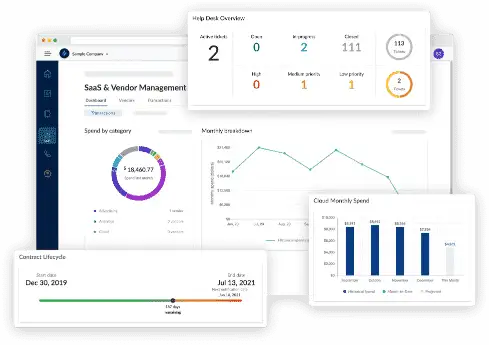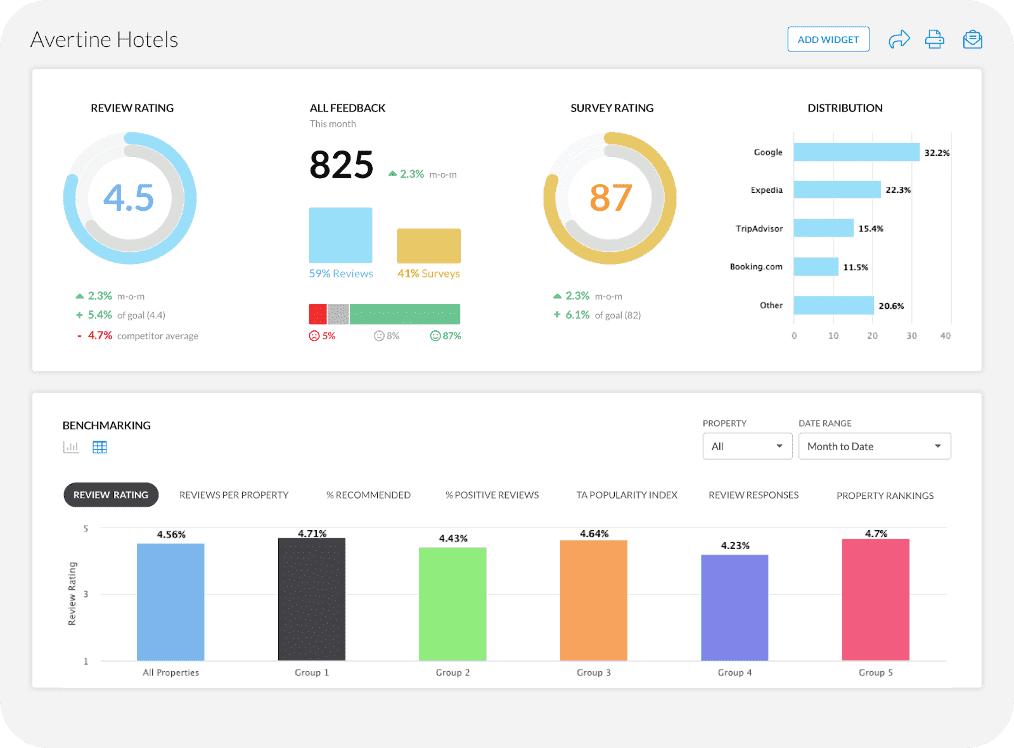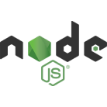According to Statista, the global IT outsourcing market will reach $541.10 billion. This suggests an annual growth rate of 8.48%. Moreover, this is because agile product teams are under constant pressure to innovate and release builds faster. However, even the most capable in house teams can hit roadblocks. So, this is where tech team augmentation can help.
Also, companies looking to remain ahead in fiercely competitive sectors are finding that tech team augmentation is a strategic asset that allows them to rapidly increase their development skills and sustain delivery velocity without overstretching their own teams.
In this blog, we will look at how tech team augmentation empowers agile product teams.
What is Tech Team Augmentation?
Tech team augmentation is a modern staffing strategy that enables organizations to scale their development capacity by integrating external technology professionals directly into their teams. Rather than outsourcing an entire project to a third party, companies handpick skilled professionals to work alongside their internal teams.
You can think of it as a plug and play talent solution. So, when a product team lacks the time or manpower to meet delivery goals, augmentation allows them to quickly access specialized expertise or expand their workforce without the overhead of hiring full time employees.
Characteristics of Tech Team Augmentation

Direct Integration
Augmented professionals become part of your internal team and participate in sprint planning and code reviews.
Flexible Contracts
Depending on the project, augmented resources can be brought in for a week or several months. This allows businesses to scale up or down as needed.
Focused on Skills
Whether you need a full stack developer or a machine learning developer, augmentation allows you to source talent tailored to your current tech stack or project requirements.
Difference Between Team Augmentation and Other Engagement Models
| Model | Description | Best For |
| Tech Team Augmentation | You can supplement your internal team with external developers who work under your management. | It’s best for Agile teams needing flexibility and control. |
| Managed Services | Delegate a specific function to a vendor who manages the delivery. | It’s for repetitive and standalone tasks. |
| Project Outsourcing | Your entire development is handled externally with a fixed scope and budget. | It’s best for projects with grid requirements. |
Why Agile Product Teams Need Augmentation?
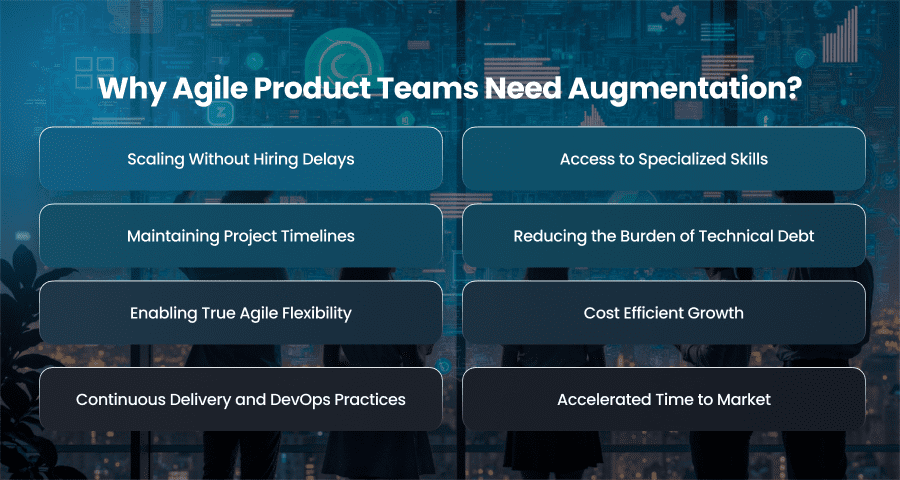
Scaling Without Hiring Delays
In Agile environments, speed is paramount. New features and user stories must move from the backlog to production quickly. However, hiring full time employees can take days and months. Moreover, onboarding and training can also take up a lot of time.
Tech team augmentation enables product managers and Scrum masters to scale teams instantly by onboarding pre vetted professionals who can hit the ground running. Whether you need a React developer for a product sprint or a DevOps expert to support continuous deployment.
Access to Specialized Skills
Agile product development often requires diverse technical expertise. These expertise can include mobile development and API integration to cloud architecture and data analytics. Also, internal teams cannot always have the breadth of skills needed for a specific feature or sprint goal.
With tech augmentation, you can bring in niche talent for specific phases or tasks without long term commitments. Moreover, this flexibility is especially valuable for Agile teams that operate in cross functional productions or switch priorities quickly based on customer feedback.
Maintaining Project Timelines
In Agile development, consistency and collaboration drive results. But what happens when a developer goes on leave or some developers resign unexpectedly?
So, rather than burning out existing team members or putting velocity at risk, teams can use augmentation to stabilize operations and preserve team rhythm.
Reducing the Burden of Technical Debt
Agile often prioritizes delivery over perfection, which can lead to mounting technical debt over time. However, Agile teams rarely have extra bandwidth to refactor code or implement performance improvements.
Hence, by augmenting your team with experienced developers focused on technical debt resolution, internal developers can continue sprint work while legacy issues are cleaned up in parallel.
Enabling True Agile Flexibility
Agile is built around the ability to respond to change without following a fixed plan. But without scalable resources, teams can find themselves unable to act on changing priorities. Moreover, tech augmentation ensures that Agile teams adapt quickly, whether that means increasing dev capacity for a new product launch or switching focus to infrastructure enhancements after a performance incident.
In essence, augmentation adds agility to Agile. It gives teams the freedom to take on more ambitious goals.
Cost Efficient Growth
When you hire full time developers then it can be a more costly option. These costs include salaries and training. For Agile teams in the startup phase, this cannot be financially feasible.
Augmentation offers a cost effective way to grow your development power. Hence, this helps Agile teams maintain lean operations while still delivering results at scale.
Continuous Delivery and DevOps Practices
Many Agile product teams build deployment pipelines to release faster and more frequently. But to maintain that pace, you need test automation developers and cloud infrastructure experts. Tech team augmentation allows you to build a DevOps team without restructuring your team.
Accelerated Time to Market
Augmentation can help you expand your team instantly, reducing bottlenecks and ensuring that product features are released faster. With more hands on deck, you can complete user stories more efficiently and push updates or MVPs to market ahead of competitors.
Best Practices for Successful Tech Team Augmentation
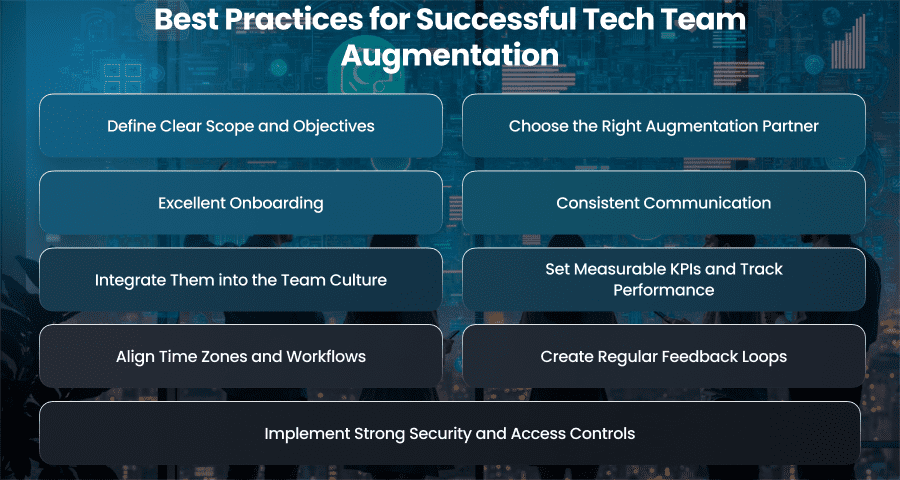
Define Clear Scope and Objectives
Clearly defining the scope and goals of your project is essential before enrolling any enhanced team members. This entails determining the precise positions you must fill as well as the precise outputs you require.
A well defined scope ensures that the external developers are aligned with your sprint goals from the beginning and can contribute effectively without confusion or delay.
Choose the Right Augmentation Partner
You should choose a partner that understands Agile methodologies and has experience supplying developers for fast paced environments is essential. Hence, you should look for a partner that thoroughly vets their talent pool and offers flexible engagement models. Also, they should prioritize both technical and cultural compatibility.
Excellent Onboarding
Effective onboarding sets the tone for collaboration and productivity. Even if the developer is remote or temporary, they should go through a comprehensive onboarding process. This includes sharing your product’s vision and user personas. Furthermore, you should tell them about your teams structure and give them access to your repositories and documentation. Hence, a well boarded developer can become productive faster and will feel more engaged with the team and its mission.
Consistent Communication
In Agile environments, communication is the glue that holds everything together. Augmented developers must be included in daily stand ups and retrospective meetings. Moreover, you should provide access to your preferred communication channels, like Slack or Teams.
Integrate Them into the Team Culture
To get the best out of augmented developers, treat them as integral members of your team. Moreover, you can include them in decision making and virtual team building activities. When developers feel included, they are more likely to take ownership of their work and go the extra mile.
Set Measurable KPIs and Track Performance
You should set measurable KPIs that align with Agile principles. These principles include sprint velocity and defect rates. You should apply these metrics to both individual contributors and the overall impact of the augmentation model. Moreover, regular performance reviews help ensure that goals are being met and provide a framework for making data driven decisions about expanding or scaling the augmented team.
Align Time Zones and Workflows
Time zone differences can be a hidden challenge in tech team augmentation. So, to ensure smooth collaboration, you should set expectations early around overlapping working hours and availability for sprint meetings. Hence, when coordinated properly, even global teams can operate seamlessly.
Implement Strong Security and Access Controls
Security and access management are critical in any augmented team model. Since external developers will often access sensitive codebases or infrastructure, it’s important to establish secure protocols. Moreover, provide limited role based access and version control systems. Additionally, ensure that a well defined offboarding procedure is in place to quickly terminate access at the conclusion of contracts. Thus, this protects your intellectual property and guarantees adherence to industry rules, particularly in fields that handle sensitive data.
Create Regular Feedback Loops
Feedback is a cornerstone of Agile development, and it should extend to augmented team members as well. Moreover, you can schedule regular check ins to gather insights from both internal and external contributions. This continuous feedback loop allows you to refine the augmentation process and ensures everyone is on the same page.
Challenges in Augmenting Tech Teams
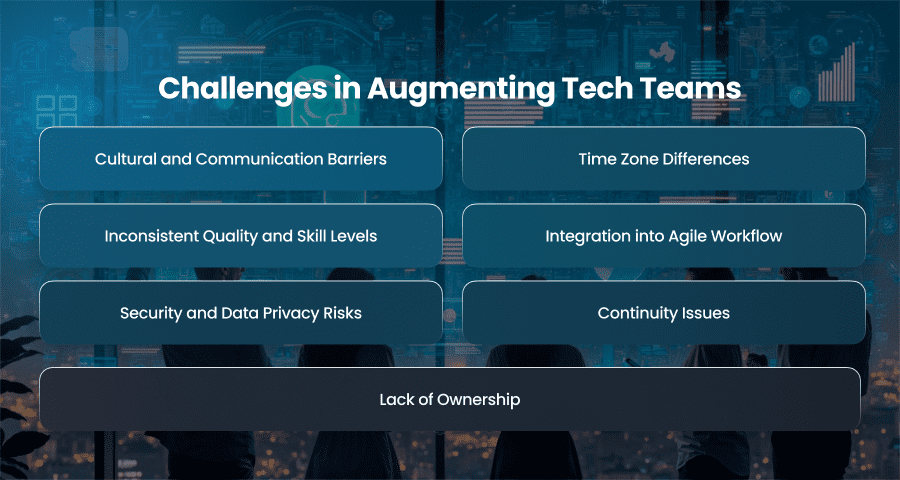
Cultural and Communication Barriers
Integrating developers from various linguistic and cultural backgrounds is one of the most frequent problems in tech team augmentation. Different areas may have different ways to communication and even conflict resolution. These distinctions may cause miscommunications and even conflict among team members.
Time Zone Differences
If your augmented developers are in different time zones, coordinating work can become challenging. So, tasks that require synchronous collaboration can be delayed or skipped altogether due to misaligned working hours.
This challenge is particularly significant for Agile teams that rely on tight iteration cycles and frequent feedback.
Inconsistent Quality and Skill Levels
Not every developer is of the same caliber provided through augmentation. Team members who don’t meet your standards may result from the augmentation partner’s absence of stringent screening procedures or quality control techniques. Furthermore, when developers are working on essential product features, this discrepancy may result in rework or security flaws.
Integration into Agile Workflow
Constant feedback and team cohesiveness are critical components of agile techniques. As a result, enhanced developers who are not comfortable with Agile methods may cause friction in sprints and slow down development. Moreover, even experienced developers can struggle to adapt quickly to your internal tools or sprint cadences.
Security and Data Privacy Risks
Giving external developers access to sensitive code or user data inherently carries risks. Even with NDAs in place, there is always a possibility of intellectual property theft and accidental data leaks.
Continuity Issues
The fact that developers frequently depart before the product is mature is one of the drawbacks of short-term tech team augmentation. These departures that don’t involve adequate knowledge transfer leave gaps that hinder progress and increase the strain on internal teams to continue where others left off.
Lack of Ownership
Augmented developers can sometimes treat their roles as purely task oriented, especially if they like outsiders. Hence, this can lead to minimal engagement with the product vision or customer impact. Without a sense of ownership, augmented staff might not go the extra mile or take initiative in solving problems.
Final Words
Tech team augmentation can greatly benefit Agile product teams with flexibility and access to top talent. While challenges exist, clear strategies and best practices ensure seamless integration and productivity. So, by augmenting thoughtfully, businesses can scale efficiently and gain a competitive edge.






